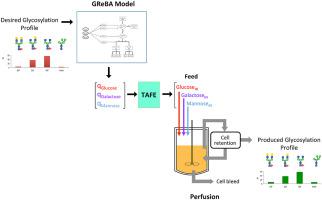Metabolic Engineering ( IF 6.8 ) Pub Date : 2020-11-05 , DOI: 10.1016/j.ymben.2020.11.004 Liang Zhang 1 , Hubert Schwarz 1 , Mingliang Wang 2 , Andreas Castan 3 , Håkan Hjalmarsson 2 , Veronique Chotteau 1

|
The N-linked glycosylation pattern is an important quality attribute of therapeutic glycoproteins. It has been reported by our group and by others that different carbon sources, such as glucose, mannose and galactose, can differently impact the glycosylation profile of glycoproteins in mammalian cell culture. Acting on the sugar feeding is thus an attractive strategy to tune the glycan pattern. However, in case of feeding of more than one carbon source simultaneously, the cells give priority to the one with the highest uptake rate, which limits the usage of this tuning, e.g. the cells favor consuming glucose in comparison to galactose.
We present here a new feeding strategy (named ‘TAFE’ for targeted feeding) for perfusion culture to adjust the concentrations of fed sugars influencing the glycosylation. The strategy consists in setting the sugar feeding such that the cells are forced to consume these substrates at a target cell specific consumption rate decided by the operator and taking into account the cell specific perfusion rate (CSPR). This strategy is applied in perfusion cultures of Chinese hamster ovary (CHO) cells, illustrated by ten different regimes of sugar feeding, including glucose, galactose and mannose. Applying the TAFE strategy, different glycan profiles were obtained using the different feeding regimes. Furthermore, we successfully forced the cells to consume higher proportions of non-glucose sugars, which have lower transport rates than glucose in presence of this latter, in a controlled way.
In previous work, a mathematical model named Glycan Residues Balance Analysis (GReBA) was developed to model the glycosylation profile based on the fed carbon sources. The present data were applied to the GReBA to design a feeding regime targeting a given glycosylation profile. The ability of the model to achieve this objective was confirmed by a multi-round of leave-one-out cross-validation (LOOCV), leading to the conclusion that the GReBA model can be used to design the feeding regime of a perfusion cell culture to obtain a desired glycosylation profile.











































 京公网安备 11010802027423号
京公网安备 11010802027423号